Nature Journaling Supplies: what you need in your bag now. Easily be prepared on your next outing with these tips and items.
Do you feel overwhelmed with starting a new course of study with nature journaling? Many people did not grow up doing nature study, and it can almost seem too simple. “You mean, we just take a notebook and pencil outside, and draw what we see?” YES!
Please note that this post contains affiliate links and I may possibly earn a commission on qualifying purchases at no extra cost to you as I am an Amazon associate.
If You are Unsure about Nature Study
But what if, “I don’t know what we are supposed to be looking at.” Or the frustration of, “What do we actually need to pack for a day out?” Because I know for me, being prepared ahead of time is half the battle. And anything that makes things easier with 4 kids in tow, I’m here for it.
Now a little disclaimer: We have been nature journaling to varying degrees of dedication throughout these five years. For some years, just being out in nature is about the best we can do. (When a baby or toddler in the lap doesn’t lend itself to water coloring.) Other years, I have been diligent about journaling and then that leads my children to dive into it more as well, by my example. No matter where you find yourself in your homeschooling journey, I want you to know that you can do this!
I remember a time when I could hardly talk my 5-year-old daughter (at the time) to be outside for more than 10 minutes. She would either be too hot, too cold, or there were too many bugs. Now, we spend hours a day outside. Not necessarily doing nature study, but Charlotte Mason’s philosophy of education has given us a rich life. So if this is very new to you and your family, start slow. Don’t judge yourself by what you see on Instagram or Pinterest. Respect your children and yourself. Like I said, start slow, but be consistent. Little bits add up.
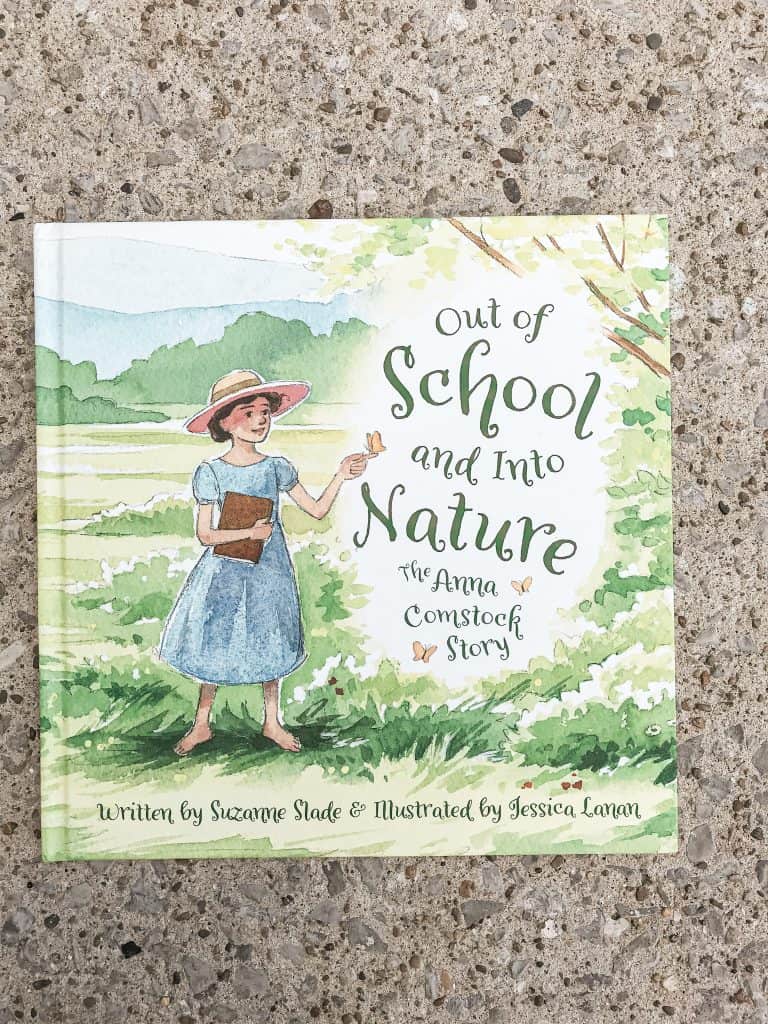
If you have young children, I’d say from ages 9 down to 5, they may enjoy this book. It is beautifully illustrated and shares the story of Anna Comstock’s life. It may help give your child (and perhaps you too!) an excitement for nature study.
Out of School and into Nature book on Amazon
What Nature Journaling Supplies We Have in Our Bag

Nature Journals and Nature Notebook: 


These are the green ones in the photo above. (Including the opened one.) These are a bit guided and give propmts. It does have lines on the pages like a notebook and the paper isn’t meant for water coloring. I found it good for beginner observers that may do well with a bit of structure and tend to use crayons/ colored pencils. The size is good for little hands as it isn’t too large. I use this for my 6-9-year-olds.
For our very little ones, we just use a decomposition notebook or any spiral notebook.
There are some also some options our friends have enjoyed for the same age range. (Updated in July 2021 to say I got this one for my 5 year old son this year. They are called Nature Journal: A Kids Nature Study Journal and have worked well!
When your child is ready to focus on watercolor or perhaps if your child doesn’t like notebook lines, move them into a moleskin watercolor pad. They come in different shapes and sizes. I like this brand and the pocket size is great for packing up to go out into nature. These can handle watercolors very well. Moleskine Classic Notebook, Soft Cover, Large
The blue nature journal in the top photo is a Guided Journal that we use as a “Book of Firsts”. (Nature Observer: A Guided Journal.) Which you basically write down the first of things in the calendar of each year to compare. For example, you use it to mark when you notice the first Robin every year and over the years you can learn when to expect to see them.
Updated July 2021: I was planning on getting my oldest two daughters Moleskine journals this year, but as I was shopping, something new caught my eye. John Muir Laws created a sketchbook that was released this spring! So I got two of these for my oldest girls to try out.
The cover is nice and thick, the paper is a good weight. It says that it is good for light washes, pencils, and pens. It also has a closure strap to keep the pages from opening inside of a backpack. The back of the book has some tips and suggestions for nature drawing/ field activities as well. I’m excited to see how these work out for us this year. Check them out here at Amazon: The Laws Sketchbook for Nature Journaling
Nature Journaling Art Supplies
Coloring Utensils
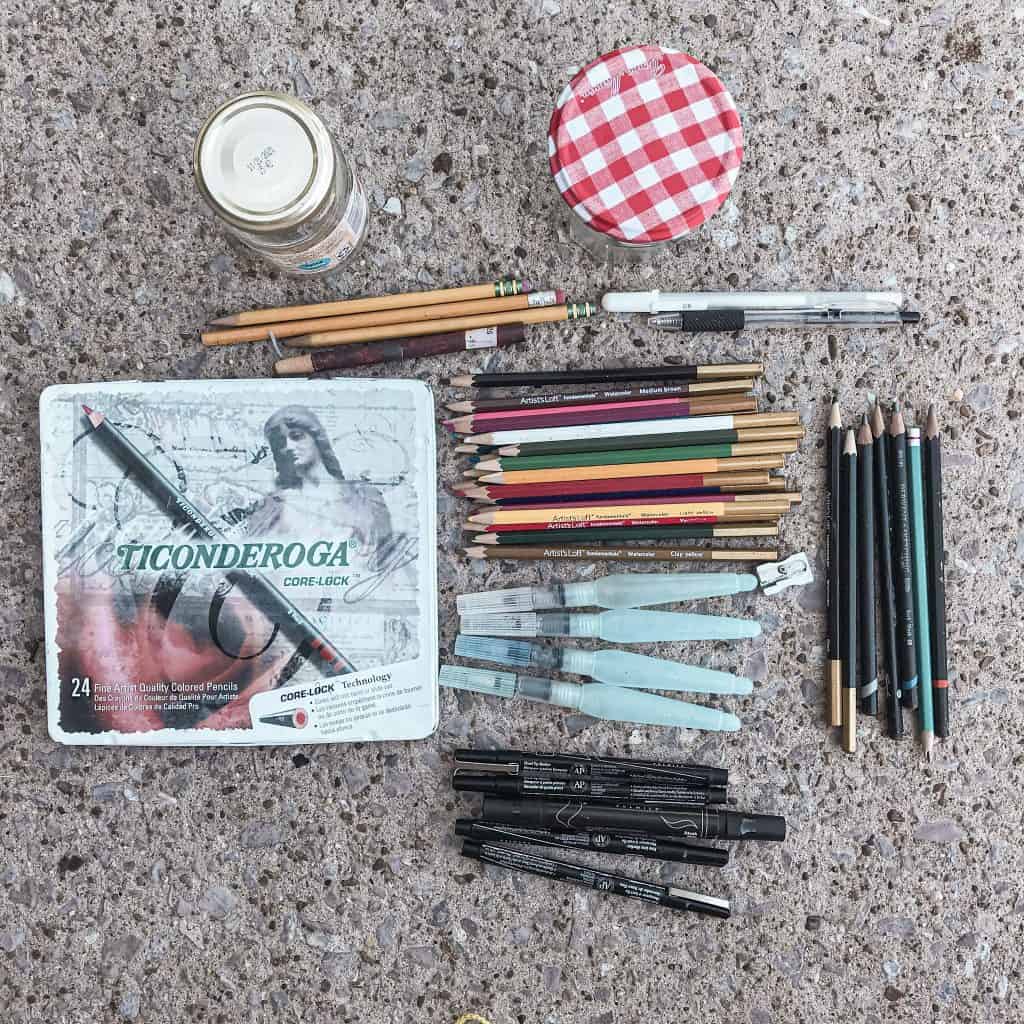
Starting from the top of this photo:
We carry repurposed glass jars for things we want to observe a little closer. It also doubles for when you need containers to hold water.
Regular pencils and erasers then followed by a white gel pen to add white highlights with watercolors.
Colored Pencils: I’ve had this tin since I was a teenager. I find the tin very useful to keep them together and not breaking when tossed around in the backpack. Here is a similar set from Amazon Basics – Premium Colored Pencils
Watercolor pencils: which is that pile in the middle. You draw what you want to and then add a bit of water to make them turn into watercolors! Faber-Castell Goldfaber Aqua Watercolor Pencils – Tin of 12 Colors
Watercolor brush pens: These things are awesome because the water goes right inside the tubes. It does take a little work to get used to them but they are a great addition to our pack. Water Color Brush Pen Set
Sketching pencils: I like to carry a variety of choices when it comes to graphite strength. As well as an eraser stick (that’s what the red stick on top is.) Faber-Castell Graphite Sketch Pencil Set
Fountain Pen: A nice fountain pen is also nice to have tucked into the bag of art supplies. Pilot Varsity Disposable Fountain Pens
Nature Journaling Supplies: Sketching Items
Sketching pencils in various degrees of lead hardness are great to achieve different shades while field sketching. Faber-Castell Graphite Sketch Pencil Set
Pencil Sharpener: Important to remember when carrying all these pencils.
Did you know that if you use PrismaColor colored pencils, their core is actually softer than normal pencils? They have a specific pencil sharpener for their products.
Black Felt tip pens: I like to use these to outline some sketches or to write our observations in our nature journals. I carry a variety of sizes but my favorite one that I am usually reaching for is 03. I find that it’s not too thin and not too thick. Prismacolor Premier Fine Line
And last but not least if you missed it up top, is a white gel pen to add white highlights when needed. I find watercolors to be frustrating sometimes. If you are like me, that negative space vanishes quickly. Since there isn’t a way to bring it back, this is a handy little thing to have to add it back in. (picture below above the open colored pencil case.)
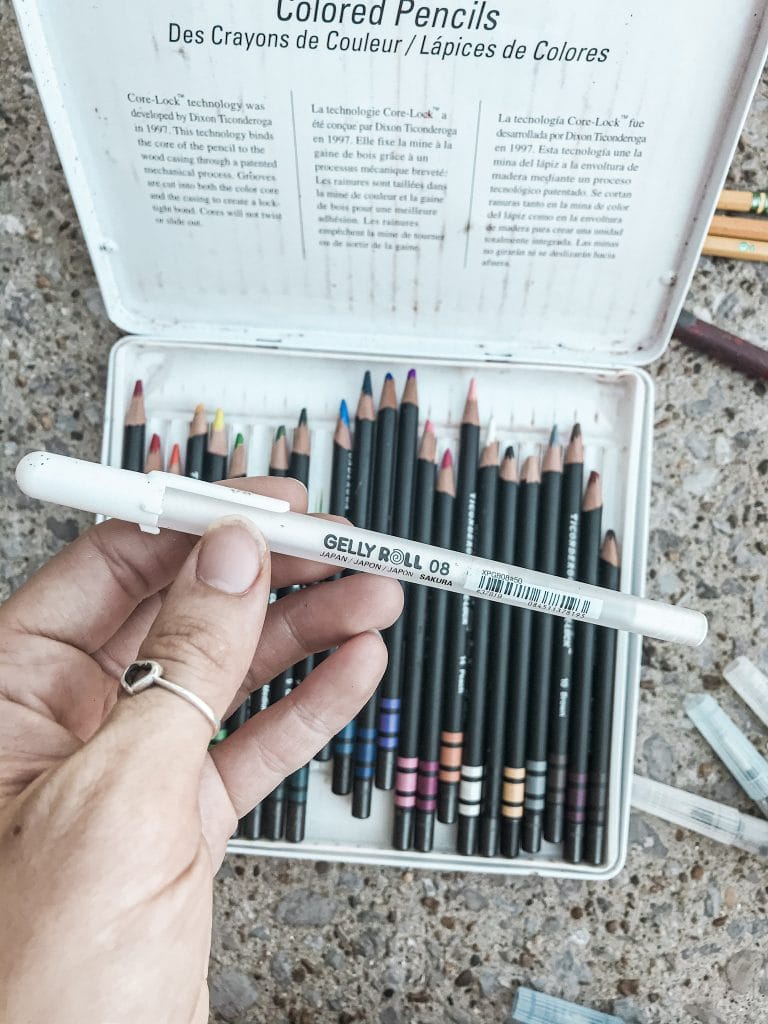
I will say, this big set of Prismacolor colored pencils does get a lot of use at home. It is a splurge though! Prismacolor Premier Colored Pencils 150 Count. I don’t take these out in the field because of the cost and the size. But if you get a smaller pack, they may be just right for you.
Prismacolor Premier Colored Pencils has a nice 12 pack size for when you are out studying the natural world.
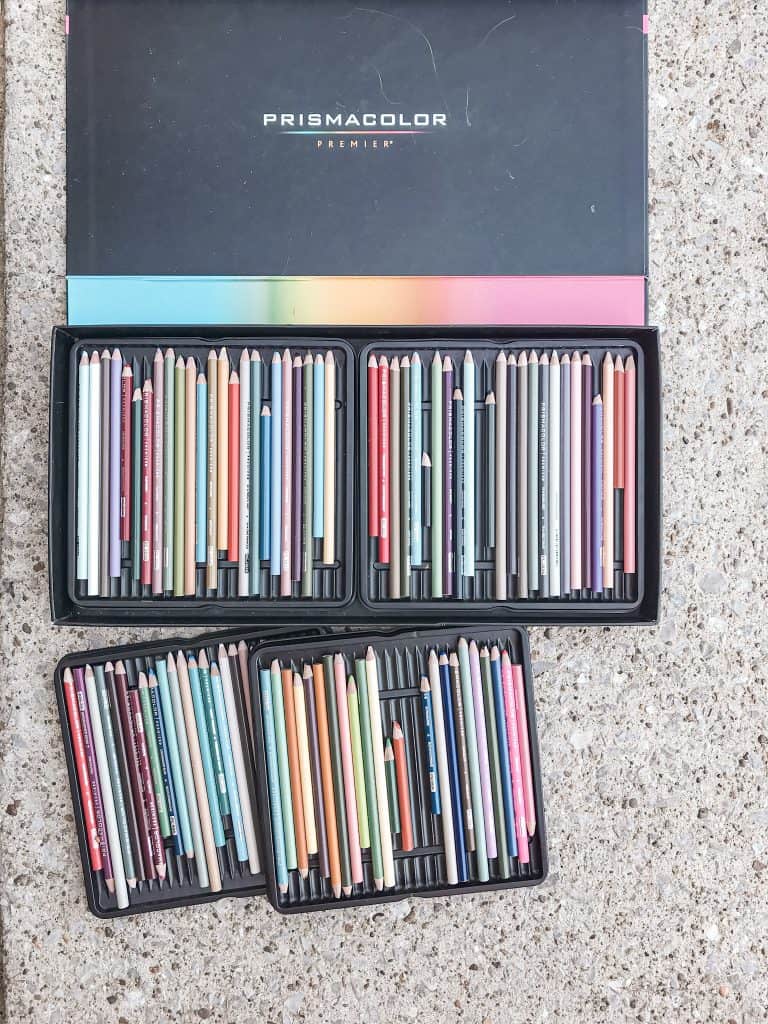

Water Color Supplies for Nature Journaling
I do not carry all of these for each outing, but I want to show you the options that we like.
The top left corner is not watercolors. Lol, those are our beeswax color sticks which technically should have been in the last section, but they are in this photo. I bring these for the littles when they aren’t yet ready to work with watercolors. Being that they are beeswax, the melting point is higher than the brands the big box stores carry. I have yet to find one of these melted at the bottom of a bag. Stockmar Beeswax Stick Crayons
Top Right is a pan of watercolors with bright fun colors. Not usually colors that would be found in nature, but a cheaper option.
The larger set of Winsor and Newton watercolors is my set and the smaller one is one that my big girls will get this coming year. I will also probably get them their own nature bag instead of carrying this all myself.
Large 24 pan set I have is here: Winsor & Newton Cotman Watercolor Paint Set, Studio Set, 24 Half Pans
12 pan set :Winsor & Newton Cotman Watercolor Paint Set, Sketchers’ Pocket Set, 12 Half Pan w/ Brush
On the side is liquid watercolors that I have used to replace colors as needed. Winsor & Newton Cotman Watercolor Paint Set. If you really would like to see how a pro arranges their watercolor palette, check out John Muir Laws share about it here.
One last item for watercolors that is nice to have is these Ready Cut Watercolor pages. We use these if the paper in our journals doesn’t lend itself to water coloring and we want to paste something in on top. Or perhaps you have someone who is frustrated with how their picture turned out, these are nice for a second try. Then tape or paste them on top of the page that needed a second chance. 😉
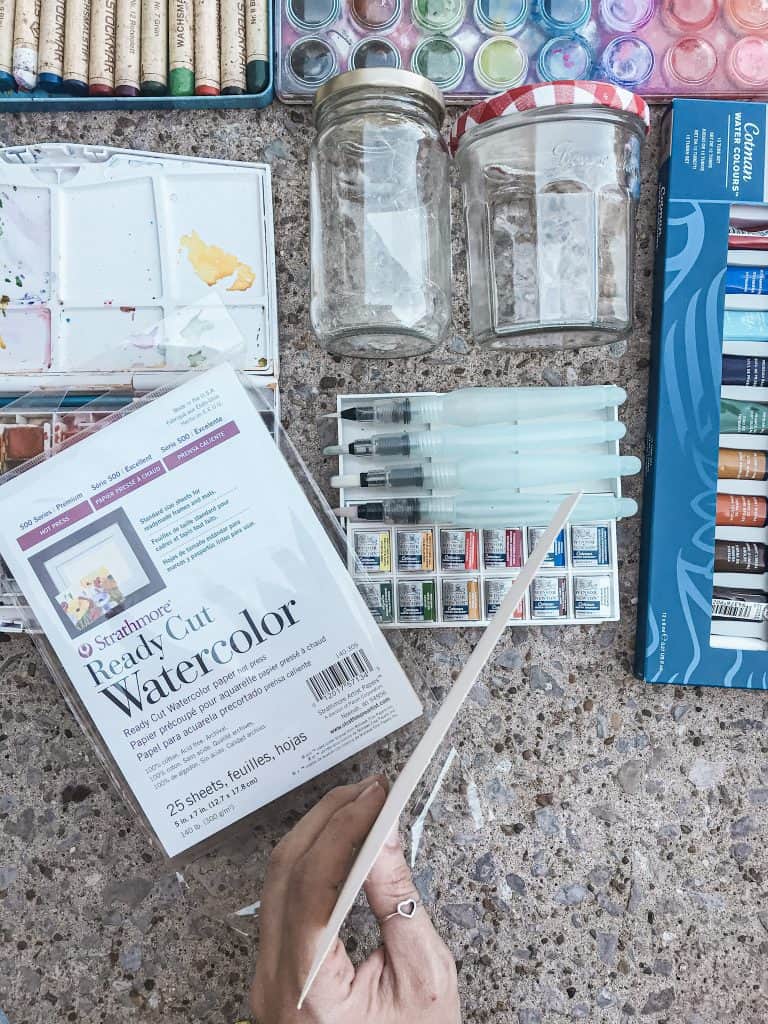
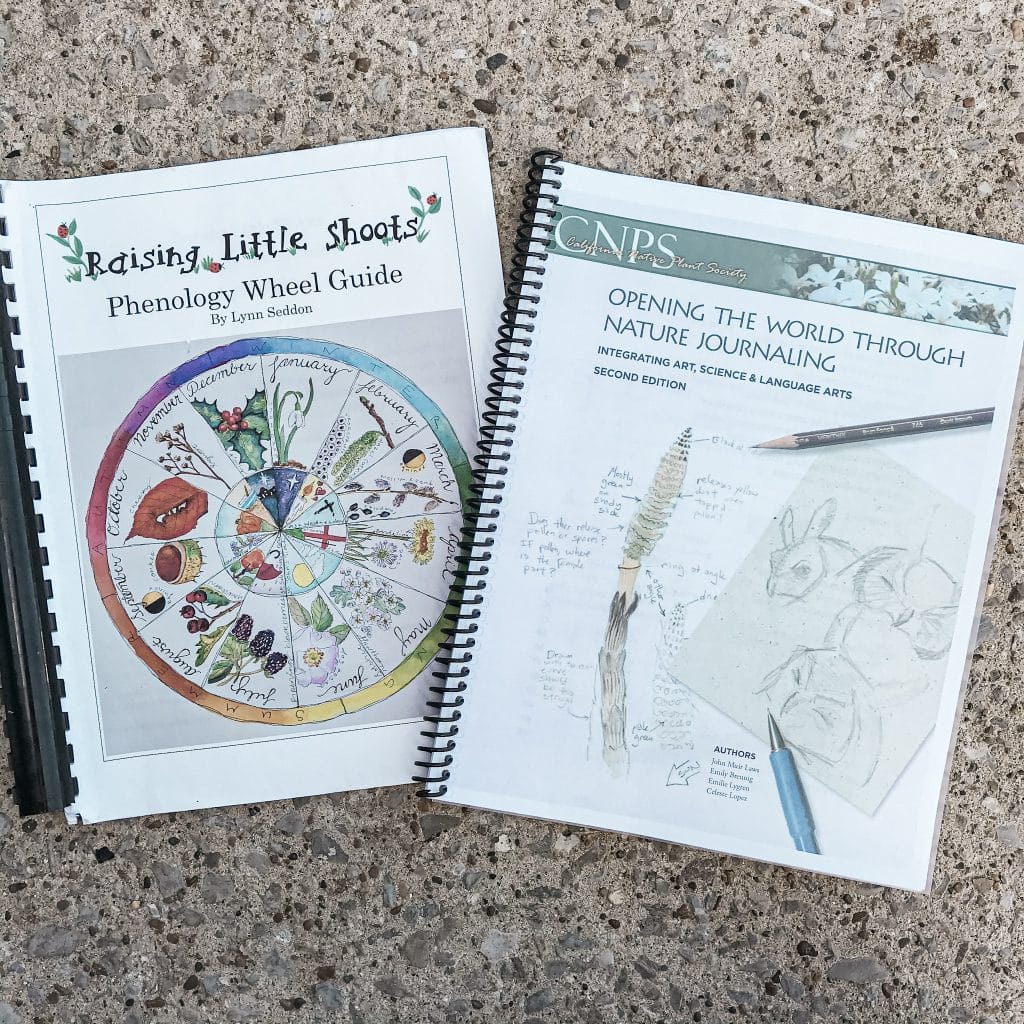
Nature Journaling Resources
John Muir Laws has many amazing resources for teaching and learning how to do nature study, including this free Nature Journaling Curriculum!
Raising Little Shoots has great resources as well and I can’t believe I didn’t photograph Exploring Nature With Children! She created that and if you would like something to give you guide you step by step, season by season, this is it.
The cost is low but the expense can come from printing it. Get a couple of quotes from local print shops, if you can. Otherwise printing through The Homeschool Printing Company is very economical, although it can take a long time for your order to be sent to you.
The Phenology Wheel activity was a fun one to put together with the kids. It makes a beautiful pictorial image of what you are charting. We used it for a weather study.

Nature Field Guides
Although I do love the “Seek” app to identify things while we are out exploring, there is something to learning how to operate a field guide.
Find some great guides that are local to your area like this Birds of Tennessee field guide for us in Tennessee.
The whole series of Golden Field Guides are gems. I actually grew up with an earlier edition of this book that is still at my parent’s house. Birds of North America
Trees: Revised and Updated (A Golden Guide from St. Martin’s Press)
Golden Guide 160 Pages Paperback Insects Book (A Golden Guide from St. Martin’s Press)
Reptiles and Amphibians: A Fully Illustrated, Authoritative and Easy-to-Use Guide
Golden Guide 160 Pages Paperback Field Guide to Butterflies and Moths Book
Stars: A Fully Illustrated, Authoritative and Easy-to-Use Guide

Nature Books to Encourage the Love of Nature in the Home
I wasn’t going to gather every single book that I have around my home that I use to encourage a love of nature in my family. But there are a few that I felt would be amiss if they weren’t included in this post.
The Julia Rothman books: They aren’t a book that we often use to study specific topics but both my oldest daughters have sat and read through them in their entirety, coming away with increased knowledge.
The Julia Rothman Collection: Farm Anatomy, Nature Anatomy, and Food Anatomy
The Handbook of Nature Study by Anna Comstock: Does that name sound familiar from earlier in this post? This is one of the pieces of work Ms. Comstock wrote and is a wealth of information.
For some people, it is too much information, which is why I am excited that the Living Book Press has redone them breaking them up into topics. They have also updated the pictures. But the original is more cost-effective if you can work with it.

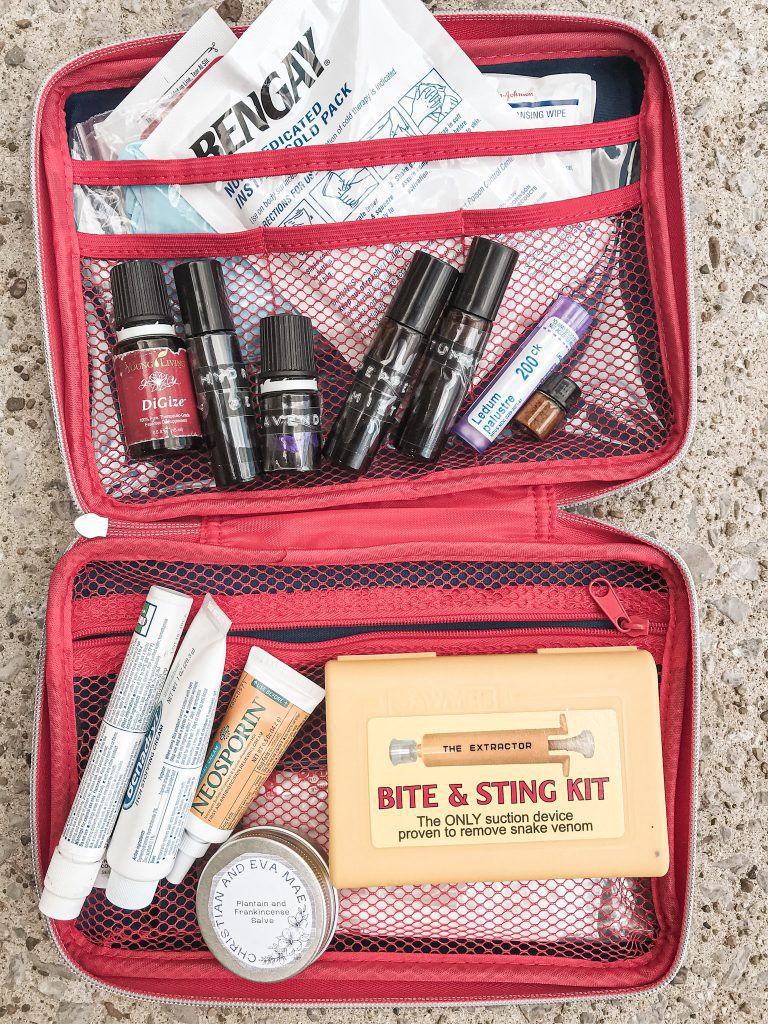
A Few Last Items I Recommend for Your Nature Journaling Supplies
A pocket knife comes in handy for many purposes. Of course, take caution as to where you store it in the bag and use your discretion for your family situation.
Binoculars are a great item to put on children’s birthday or Christmas wish lists.
Compass: fun for kids to start using early on to get a good sense of direction. The one pictured is a military version from when I was in Civil Air Patrol as a teenager. A basic one will do for hikes and maps.
Whistle: I use this when kids start wandering too far off or during our nature group when there are lots of voices all at once. If you are going on a hike, sometimes it is nice to give one to each child in case they get lost.
Tape Measure: very useful when you are wondering how some things compare to others or how deep a stream may be.


Magnifying Glass or Lupe: to see those little details that we may otherwise miss out on. The magnifying glass in the first picture on top is just a basic one from Dollar Tree. They don’t always carry them, so I will leave an option from Amazon as well.

I usually carry a personalized first aid kit where ever we go out. This includes the typical first aid type items as well as essential oils, tick care (Boiron Ledum Palustre 200ck) and a bite and sting kit.
Free Printable!
If you need some help feeling prepared, print these off and use them as a check list.
I made these last fall when starting our own nature study group, and needed to make sure we had everything. (You can start one too! I wrote about it here).
I double-sided mine and laminated it till we got in our rhythm of remembering everything. Hopefully, they make things a little smoother for you and your crew when trying to get out the door.
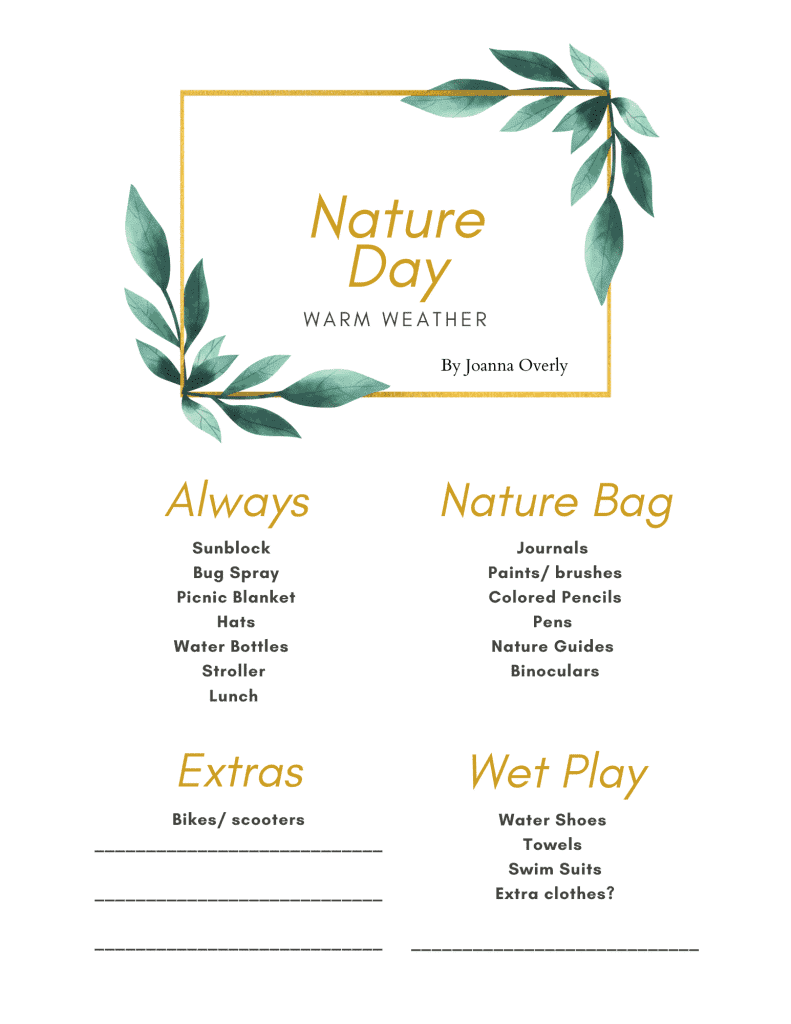
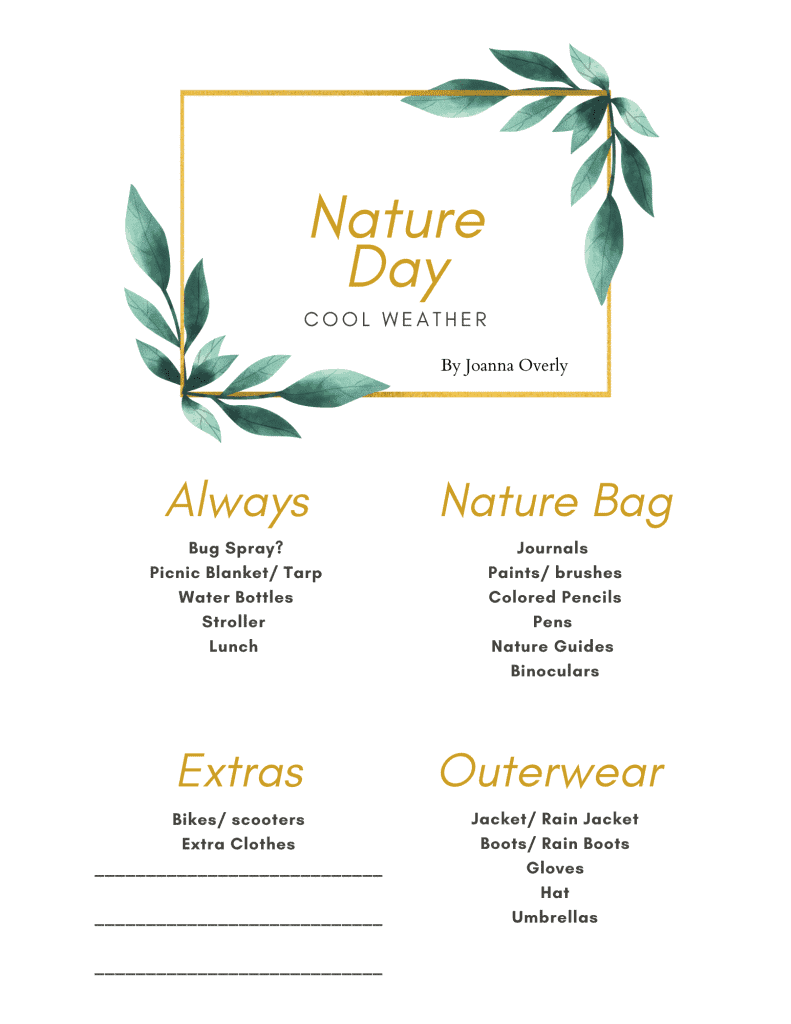
If you’d like to see how we implement a Charlotte Mason education into our home you can see read more here:
How to Homeschool Multiple Ages: with 10 Tips

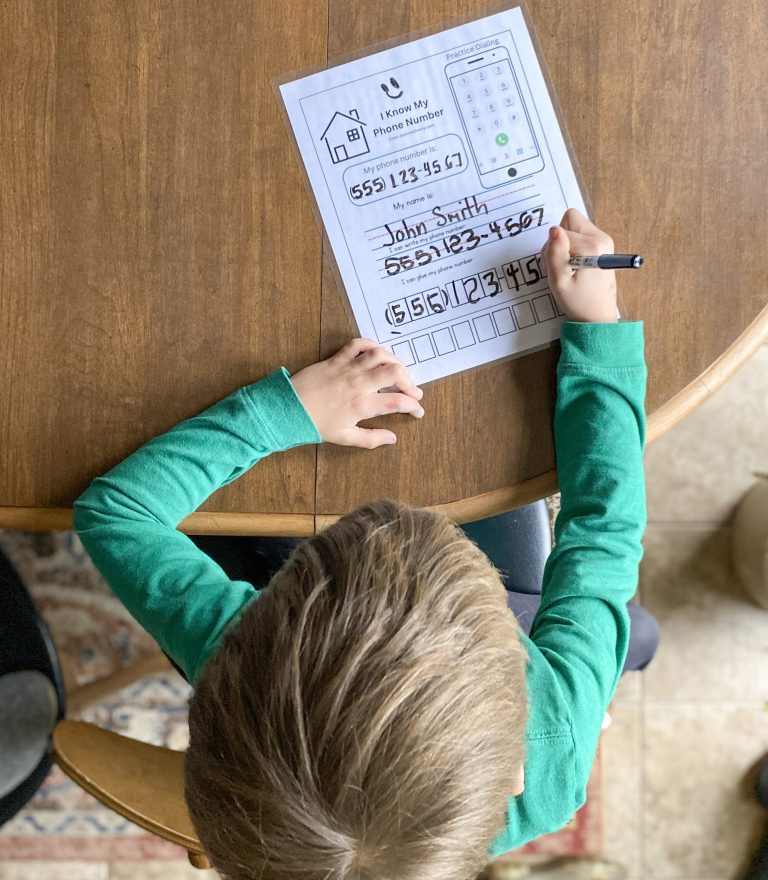
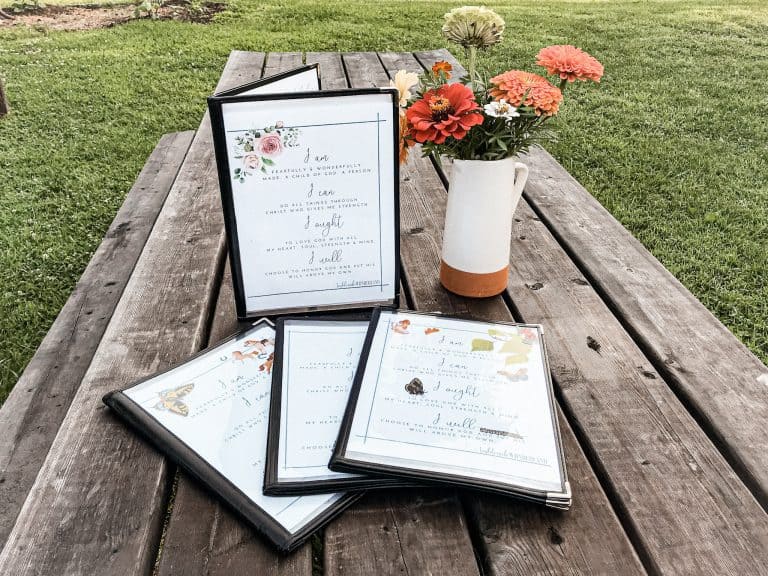
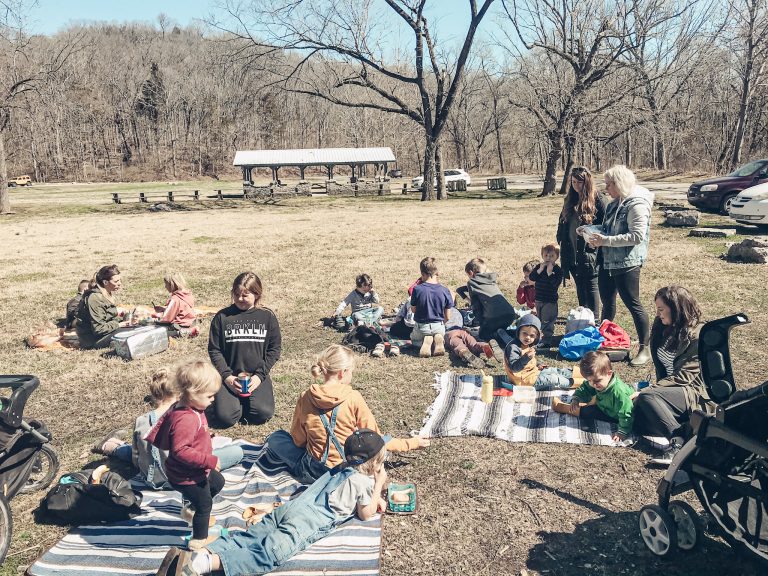
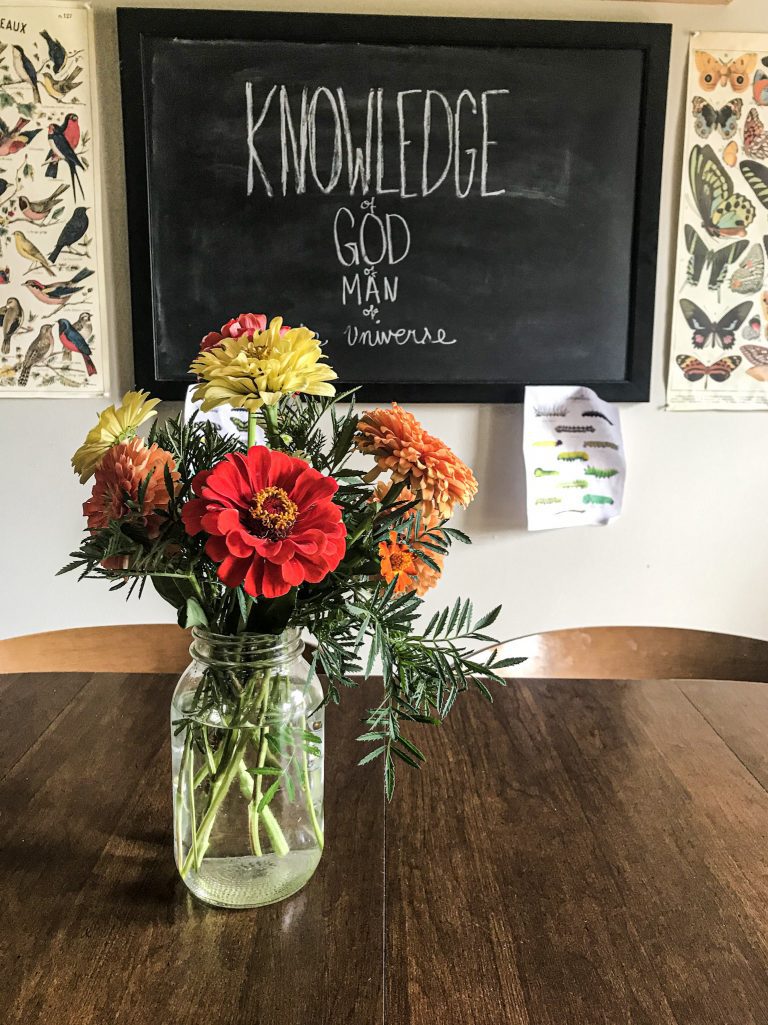
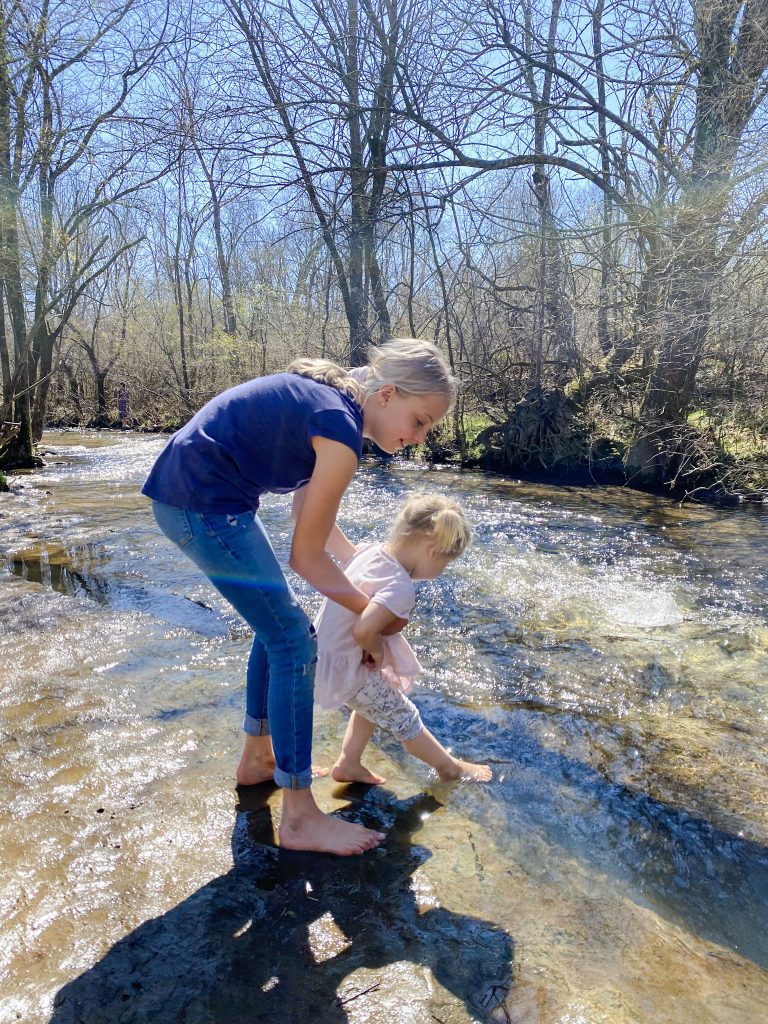
This was such a wonderful, informative post! Thank you for sharing these tips. I am currently a 4th grade teacher at a Classical School. I am transitioning home, and looking forward to doing this with my children in our homeschooling journey. I did implement it at school. It was the students favorite part of their week! I do have a question about the beeswax crayons. How long have they held up for you? That is definitely an investment for my toddlers but I’ve always loved the idea of using them.
Thank you for reading! I pray blessings over your transition to home education.
The beeswax crayons have held up extremely well. We’ve had some of ours for 3-4 years. They are thick, which is nice for little hands but also they don’t snap easily. Ours just look beat up since one of my children likes to take the papers off them, but that doesn’t affect their usefulness at all. 🙂